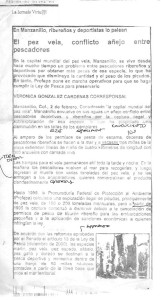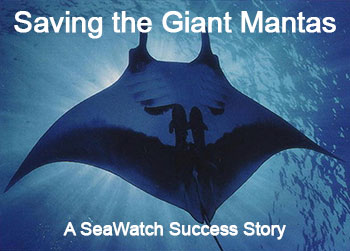
No Dorado or Sailfish in the Sea
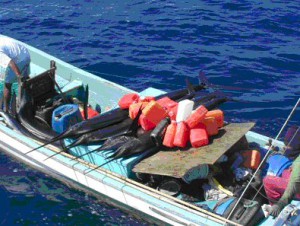
Panga Longliner with Billfish
Panga longliners started about 1985 when 200 special permits were issued in Manzanillo for longlining shark. The by- catch of primarily sailfish and some dorado was over 95% of the total catch. At that time these pangas were landing between 150-200 tons of sailfish monthy into the Manzanillo markets. It was from these original 200 permits that the huge panga longline fleet of more than a thousand pangas rapidly developed. By the mid 1990’s sailfish and dorado were severally depleted in the Sea of Cortes and today they are almost gone.
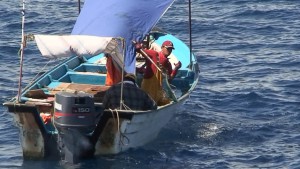
Panga longliners caught around 1500 to 2000 kilos of dorado daily/panga in the mid to late 1980’s and could make over $500 usd per fishermen.
Long-Lining for the Fish of Gold
A story of two brothers from Guaymas in the mid 1990’s – written by Mike Brozda as told by Edgar Calderon.
It’s 3 AM on a muggy June morning in 1994 in the seaside city of Guaymas on the mainland side of the Sea of Cortes. In the pre-dawn darkness, teenage brothers Jose Luis and Edgar Ceseña Calderón are preparing their 26-foot-long panga for a marathon fishing session. Their target is one of the most beautiful, hardest-fighting, mouth-watering fish in the world. By any measure, Coryphaena hippurus are magnificent creatures. Found in tropical and subtropical waters around the world, the fish are known by several different names, which sometimes causes confusion. In the Hawaiian language, and on many menus, the fish are called mahi-mahi, meaning “very strong fish”.
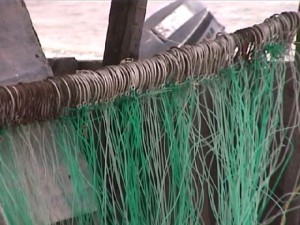
Panga longliners set between 2000 and 2500 hooks daily
In Mexico and many Spanish-speaking parts of the world, the fish are known as Dorado, meaning “golden,” which is my favorite name. Dorados have dazzling golden colors running the length of the body on both sides of their bodies, and, while they’re alive, bright blues and greens on the sides and back. With their long, slender bodies, Dorado are hard-fighting, flashy fish capable of incredible bursts of speed and have been clocked up to 92.6 km/hr. (57.5 miles per hour).
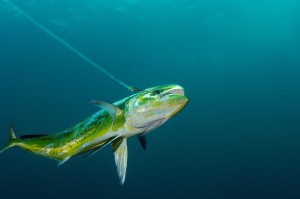
This beautiful dorado hooked by an illegal panga
longliner near San Marcos Island.
Everything aboard the Calderón brothers’ panga is arranged for maximum efficiency. Two-hundred-and-thirty kilograms (500 pounds) of shaved ice are packed into three different holds aboard the boat. Hundreds of barbed steel fishhooks dangle neatly from the gunwales, along with one-liter plastic milk jugs that will serve as floats to mark the hooks once they are in the water. Coiled on the foredeck is about 10 kilometers (6 miles) of pinky-finger-thick polypropylene line (linea madre) and on special racks hung over 2000 hooks lines and clips. The Calderón brothers are long-lining for dorado. During June, July and August, the blistering summer season when dorado are biting on the Sea of Cortez, the brothers will work nonstop for up to 22 hours per day. “It’s terrible work, and I hated it,” said Edgar Calderón. “Sometimes I wouldn’t see my family for days or weeks at a time.”
High Earnings Drive Illegal Fishing
Leaving from Guaymas, about 1:30 am, they first catch squid and then head for the Baja. It takes the brothers more than two hours of blasting through the chop to reach to their fishing grounds off Baja California’s San Marcos Island by 5:30 am. In a well-choreographed deadly ballet, they toss a plastic barrel with a flag, tied to one end of the linea madre and immediately begin feeding out the polypro line. Every 5 meters (16 feet) they clip a baited hook and a plastic float bottle onto a four-foot-long leader. Motoring slowly, it takes more than four hours to set the entire six miles of line and over 2000 baited hooks.
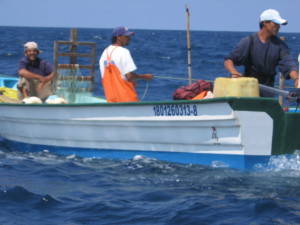
During the height of the fishery in the late 1980’s
and early 1990’s over 700 pangas from
Guaymas
worked in this fishery
Now the hard, bloody work begins. Quickly returning to the plastic barrel, the brothers begin to pull in the polypro line. A sharp knife flashes as each fish is bled out and tossed into the hold. A layer of fish, a layer of ice. Repeat. Re-set the hook on the gunwale rack and bring in the float. As they die in the hold, the Dorados quickly lose their rainbow colors and the skin fades of a lifeless gray. By the brothers’ count, many hooks contain a Dorado; a few are empty. The rest of the catch is considered “worthless.” There are seabirds, sharks, rays, turtles, perhaps an occasional juvenile marlin or sailfish. By the time they return to Guaymas, unload and sell their catch it is usually after 11 pm.
When the Calderón brothers first began long-lining for dorado in 1994, late in the game as dorado were already declining, a good day’s catch could bring in as much as 2180 kilograms (4,800 pounds) of illegal fish.
This was from an old 2002
Manzanillo newspaper talking
about the 150 to 200 tons of Pez
Vela (sailfish) killed monthly by
the pangas
with the
newly issued shark permits.
In three days of successful dorado fishing, the Calderóns earned far more than the entire year’s salary of a Mexican laborer.
Edgar, now 42 and Jose Luis, 38, gave up long-lining 1996 when the dorado populations became so depleted that it was no longer profitable to fish. “During the height of the Guaymas-based fishery, the approximately 70 pangas in the Calderon brothers cooperativa were bringing more than 80 tons of Dorado per day to the beaches located near the Navy base in Guaymas,” McGettigan says. There were 10 times that many boats (700) working dorado just from the Kino to Guaymas area. “7 years of illegal fishing by over 1000 pangas had decimated the dorado fishery in the Sea of Cortez” and 20 years later dorado populations are still declining in the Sea of Cortez.
A must see video (in Spanish) that nails the Dorado problem. Done by Vince Radice:
July 22, 2015
SeaWatch Newsletters
What's New at SeaWatch:
SeaWatch Dream Come True
Since September of 2021, when our attorneys first petitioned the government to create large no take zones around Espiritu Santo National Park to facilitate reef and reef fish recovery, we have been building a dream team. A year later we have that team and a plan in place that is doing exactly that. To see the problem and solution. Click to view this short video...
SeaWatch Annual Raffle
Scott Hanson donated his popular 19" bronze limited edition sculpture "Smooth Sailing" that retails between $7,700 and $9,250 depending on the gallery. Buy one or more tickets here. But hurry as only 150 raffle tickets will be sold!.
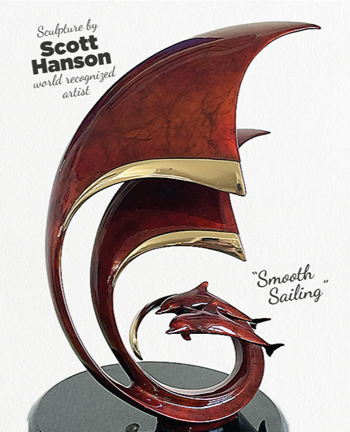
Creating the Next Cabo Pulmo
Fisheries Recovery in the Sea of Cortez
Where there are fish of any commercial value, fishing interests will find a way to take them.
In 2019 and 2020 with the legalization of fish traps in the Espiritu Santo National Park (banned in most other places 30 years ago) it became clear that where there are fish, fishing interests will find a way to take them. Read More...
Fish Traps Devastate Marine Environments
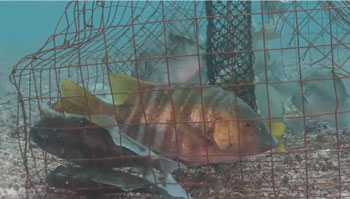
Watch this video to see the evidence of the devastation caused by fish traps on reefs and reef fish over time. These traps are legal in Mexico and tragically in Espiritu Santo National Park. To learn more about fish traps and see the devastation they cause Click Here...
Sea Lions and Fish Nets
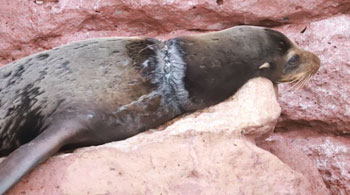
This video shows the entanglement of sea lions in fish nets and fishing gear in the Sea of Cortez. "Is this what we want in the Espiritu Santo National Park?"
Find SeaWatch On Facebook and You Tube


How You Can Help Save the Sea of Cortez
Consume Responsibly
Abstain from eating all fish that protect the health of the reefs including parrotfish and surgeon fish
Report Illegal Activities
Be our "Eyes on the Water" take photos, record positions, and send reports to the authorities
Donate
Your donations contribute to the work of Espiritu Santo es parte de ti and the efforts of ROC
